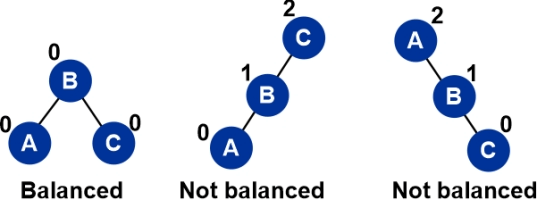What is the Balance Factor of AVL Tree?
AVL Tree
In 1962, GM Adelson-Velsky and EM Landis created the AVL Tree. To honors the people who created it, the tree is known as AVL.
The definition of an AVL tree is a height-balanced binary search tree in which each node has a balance factor that is determined by deducting the height of the node's right sub tree from the height of its left sub tree.
Why to use AVL Trees?
The majority of BST operations, including search, max, min, insert, delete, and others, require O(h) time, where h is the BST's height. For a skewed Binary tree, the cost of these operations can increase to O(n). We can provide an upper bound of O(log(n)) for all of these operations if we make sure that the height of the tree stays O(log(n)) after each insertion and deletion. An AVL tree's height is always O(log(n)), where n is the tree's node count.
AVL Trees
Due to the fact that, AVL tree is also a binary search tree hence, all the operations are conducted in the same way as they are performed in a binary search tree. Searching and traversing do not lead to the violation in property of AVL tree. However, the actions that potentially break this condition are insertion and deletion; as a result, they need to be reviewed.
Insertion in AVL Trees
We must add some rebalancing to the typical BST insert procedure to ensure that the provided tree stays AVL after each insertion.
The following two simple operations (keys (left) key(root) keys(right)) can be used to balance a BST without going against the BST property.
Balance Factor
- The left sub-tree is one level higher than the right sub-tree if the balancing factor of any node is 1.
- Any node with a balance factor of zero indicates that the heights of the left and right sub trees are equal.
- If a node's balancing factor is negative one, the left sub-tree is one level behind the right sub-tree.
- In the following figure, an AVL tree is presented. We can observe that each node's associated balancing factor ranges from -1 to +1. So, it is an illustration of an AVL tree.
- We're going to talk about AVL trees today and how they're used. The worst-case performance of BST is shown to be closest to that of linear search algorithms, i.e. O (n). We are unable to forecast data patterns and frequencies in real-time data. Therefore, the necessity to balance out the current BST emerges.
- AVL trees, which stand for Adelson, Velski, and Landis, are height-balancing binary search trees. The AVL tree ensures that the height difference between the left and right sub-trees is no greater than 1. Balance Factor is the name for this.
- To better grasp the distinction between balanced and unbalanced trees, let's look at some examples:

- Because the height to the left and right of the root node is the same in the example above, we can see that the first tree is balanced. While the other two are not like that, the tree in the middle picture is lopsided to the left of the node. In a similar manner, the tree is lopsided to the right of the root node in the last image on the right, rendering it imbalanced.
Applications of AVL Trees
- Most in-memory sets and dictionaries are stored using AVL trees.
- Database applications, where insertions and deletions are less common but frequent data lookups are necessary, also frequently employ AVL trees.
- In addition to database applications, it is employed in other applications that call for better searching.
- A balanced binary search tree called an AVL tree uses rotation to keep things balanced.
- It may be used in games with plotlines as well.
- It is mostly utilized in business sectors where it is necessary to keep records on the employees that work there and their shift changes.
|
 For Videos Join Our Youtube Channel: Join Now
For Videos Join Our Youtube Channel: Join Now










